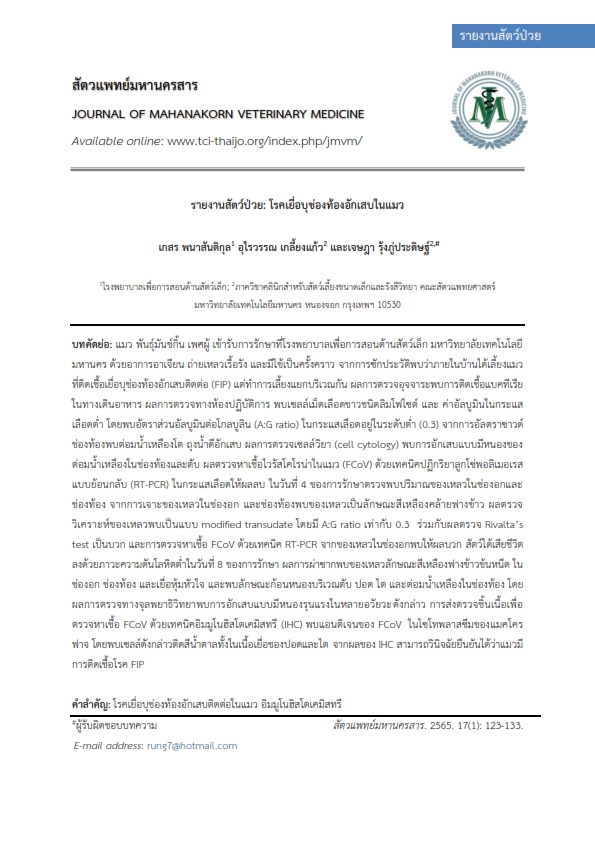Feline Infectious Peritonitis (FIP): A Case Report
Main Article Content
Abstract
A male Munchkin cat was brought to a small animal teaching hospital at Mahanakorn University of Technology. The patient presentation with vomiting, chronic diarrhea, and intermittent fever. From history-taking, the owner previously had a cat that was diagnosed with feline infectious peritonitis (FIP) living in the same house but had isolated in a separate area. Fecal examination revealed bacterial enteritis. Hematology and blood chemistry results shown lymphopenia, hypoalbuminemia, and low serum albumin/globulin ratio (0.3 A: G ratio). Abdominal ultrasound revealed mesenteric lymph node (MLN) enlargement and cholecystitis. Cell cytology from the liver and MLN revealed suppurative inflammation. Reverse transcription PCR (RT-PCR) was negative for the Feline coronavirus (FCoV) in the blood sample. On the 4th day of treatment, the cat developed pleural and peritoneal effusion. Thoracentesis and abdominocentesis were performed and submitted for analysis. The fluid’s results were classified as modified transudate, low A: G ratio (0.3), Rivalta’s test (positive), and positive for FCoV by using RT-PCR. On the 8th day of treatment, the cat died from systemic hypotension. Viscous straw yellow-colored fluid and pyogranulomatous lesions at the liver, lung, kidney, and MLN were observed from the necropsy. Histopathology’s results shown severe suppurative inflammation in all the above organs. FIP was confirmed by detected FCoV antigen in the cytoplasm of macrophages in the kidney and lung tissue by immunohistochemistry staining.
Article Details

This work is licensed under a Creative Commons Attribution-NonCommercial-NoDerivatives 4.0 International License.
References
รสมา ภู่สุนทรธรรม. 2561. โรคเยื่อบุช่องท้องอักเสบติดต่อในแมว (Feline Infectious Peritonitis; FIP). เวชศาสตร์โรคแมว (Feline medicine). พิมพ์ครั้งที่ 1. ห้างหุ้นส่วนสามัญนิติบุคคล ปอยท์ กราฟิค. กรุงเทพมหานคร. 93-94 หน้า.
Addie, D., Belák, S., Boucraut, B.C., Egberink, H., Frymus, T., Gruffydd, J.T. and Horzinek, M.C. 2009. Feline Infectious Peritonitis. ABCD Guidelines on Prevention and Management. Journal of Feline Medicine and Surgery. 11(7): 594-604.
Addie, D.D., McLachlan, S.A., Golder, M., Ramsey, I. and Jarrett, O. 2004. Evaluation of an in-practice test for feline coronavirus antibodies. J. Feline Med. Surg. 6(10): 63–67.
Barlough, J.E. and Shacklett, B.L. 1994. Antiviral studies of feline infectious peritonitis virus in vitro. Vet Rec. 20;135(8): 177-9.
Brooks, W. 2001. “Feline Infectious Peritonitis (FIP).” [Online]. Available: https://veterinarypartner.vin.com/doc/?id=8186473&pid=19239
Cohn, L. and Cote, E. 2020. In: Feline Infectious Peritonitis. 4th edition. Elsevier Inc. page. 1-2.
Felten, S., Leutenegger, C.M., Balzer, H.J., Pantchev, N., Matiasek, K., Wess, G., Egberink, H. and Hartmann, K. 2017. Sensitivity and specificity of a real-time reverse transcriptase polymerase chain reaction detecting feline coronavirus mutations in effusion and serum/plasma of cats to diagnose feline infectious peritonitis. BMC Vet Res. 13(1): 228.
Giordano, A., Paltrinieri, S., Bertazzolo, W., Milesi, E. and Parodi, M. 2005. Sensitivity of Tru-cut and fine needle aspiration biopsies of liver and kidney for diagnosis of feline infectious peritonitis. Veterinary Clinical Pathology. 34(4): 368–374.
Julie, K.L. and Hutsell, S. 2014. “Overview of Feline Infectious Peritonitis.” [On line]. Available:https://www.msdvetmanual.com/generalized-conditions/feline-infectious-peritonitis/overview-of-feline-infectious-peritonitis.
Murphy, B.G., Perron, M., Murakami, E., Bauer, K., Park, Y., Eckstrand, C., Liepnieks, M. and Pedersen, N.C. 2018. The nucleoside analog GS-441524 strongly inhibits feline infectious peritonitis (FIP) virus in tissue culture and experimental cat infection studies. Veterinary Microbiology. 219(10): 226-233.
Pedersen, N.C. 2009. A review of feline infectious peritonitis virus infection. Journal of Feline Medicine and Surgery. 11(4): 225-258.
Ritz, S., Egberink, H. and Hartmann, K. 2007. Effect of feline interferon-omega on the survival time and quality of life of cats with feline infectious peritonitis. J Vet Intern Med. 21(6): 1193-1197.
Stranieri, A., Giordano, A., Paltrinieri, S., Giudice, C., Cannito, V. and Lauz, S. 2018. Comparison of the performance of laboratory tests in the diagnosis of feline infectious peritonitis. J. Vet. Diagn. Investig. 30(10): 459-463.
Tasker, S. 2018. Diagnosis of feline infectious peritonitis: Update on evidence supporting available tests. Journal of Feline Medicine and Surgery. 20(3): 228-243.


